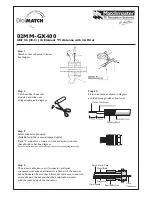
Installation and User Manual
EtherHaul
1200™
Page 172
EH-INST-02, Issue 4.0
Hint:
When using the
show
and
clear
commands, the keyword
all
may be substituted
for a list of object names. In this context, “all” means all of the objects.
For example:
eth all
is identical to
eth host, eth0, eth1, eth2
.
11.2.6.1
Multi-Dimensional Object Lists
To specify objects in a multi-dimensional object list, the symbol names (or comma-
delimited lists of names) are entered one after another, and are separated by spaces.
The generic syntax is as follows:
object {<name1>} {<name2>} {<name3>}
For example:
bridge-port c1 host, s1
specifies the bridge ports
c1 host
and
c1 s1
.
Note that not every combination of keywords is valid. For example, the command
bridge-port c1, c2 host
is invalid, because two different C-components cannot
be associated with the same port.
11.2.6.2
Designating Indexed Objects
Countable EtherHaul CLI objects are specified by their unique identifying keyword,
followed by the object’s index number. A VLAN is a typical, countable object. For
example:
vlan 230
refers to the VLAN with the index number 230
.
A complete list of indexed objects is specified in a command using a comma-separated
series. For example:
vlan 230, 330, 430
refers to VLANs with the index numbers 230, 330 and 430
.
It is also possible to specify a range of indexed objects in a command. For example:
vlan 230-270
refers to VLANs with the index numbers 230 to 270, inclusive
.
Finally, a mixed method may be used for specifying indexed objects in a command,
enabling references to both a range of objects and to individual objects. For example:
vlan 230-270, 300, 401-410
refers to VLANs with the index numbers 230 to 270, VLAN number 300 and VLANs 401
to 410.















































